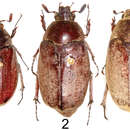Description
provided by Zookeys
Males(Figs 2, 5): BL: 20.3–22.9 mm; BW: 11.4–11.8 mm; CL/BsL=1.16–1.18; PgW/L= 1.25–1.33. Body thick, pronotum convex when viewed laterally (Fig. 5). Head, antennae, pronotum, scutellum and venter of body blackish brown, tarsomeres black, elytra dull castaneous, dorsal surface of body covered with minute, brownish grey setae. Head: Surface densely, coarsely punctate, each puncture with a seta, setae on clypeus thinner and shorter than those on vertex. Clypeus rectangular, bordered, emarginated apically; vertex moderately convex, covered with slender, hair-like and robust, scale-like setae, setae becoming longer laterally. Antennal club straight, subequal in length to basal segments. Labrum strongly bilobed at middle, symmetrical, each lobe rounded apically. Mentum with anterior margin straight, surface sparsely setigerous, setae moderately long. Maxillary palpi short, apical palpomere about 2/3 length of antennomere 3. Pronotum: Wider than long, widest at base, moderately convex when viewed laterally (Fig. 5); lateral margins well bordered but weakly developed anterior to scutellum; disc densely, evenly punctuate; punctures setigerous, fine, each with small, scale-like seta about 3 times longer than diameter of puncture, anterior and lateral margins with long, hair-like setae sparsely distributed, about 4–8 times longer than those on disc. Scutellum semicircular, surface with punctures and setae similar to those on pronotum. Elytron: Widest at middle. Surface rugose with 4 poorly developed, punctate costae between suture and humerus, sutural costa (as costa 1) and costae 2–3 complete, costa 4 vestigial; punctures and setae same as those on disc of pronotum; basal margin of elytra between scutellum and humeral umbone feebly ridged (Fig. 7). Propygidium: Surface densely punctuate, punctures setigerous; setae similar to those on disc of pronotum with a row of whitish, more robust setae along apical margin (Fig. 8). Pygidium: Lateral margins narrowly flattened. Surface densely punctate, puncture setigerous; setae scale-like, longer and more robust than those on pronotum, sparsely intermixed with long, hair-like setae (about 3–12 times longer than scale-like setae); pygidial apex truncate and concave inwardly along plane of disc (Fig. 8). Venter: Prosternal process moderately protruding, reaching base of protrochanter. Mesometasternal process feebly protruding. Metepisternum densely with hair-like setae (Fig. 17). Metepimeron and sides of abdominal sternites 1–6 with maculation consisting of brownish white, scale-like setae. Middle of abdominal sternites 1–4 almost impunctate with sides densely punctate, punctures setigerous, setae fine, scale-like, sparsely intermixed with hair-like setae 3–15 times longer. Legs: Protibia tridentate with basal tooth weakly developed. Pro- and mesofemora flattened, surface setose; hind femur more stout, surface clothed with much shorter, robust setae than those on pro- and mesofemora. Mesotibia with 2 apical spurs equal in length. Metatibia with dorso-apical spur reaching middle of metatarsomere 2; ventral apical spur of metatibia subequal in length to metatarsomere 1. Parameres: In lateral view, base of parameres (BP) strongly broadened, ventroapical swelling of right paramere (RPvs) distinctly developed (Figs 13, 15). Middle of lateral margin convex when viewed dorsally (Fig. 14).
Female (Fig. 3). BL: 22.0 mm; BW: 11.0 mm; CL/BsL= 0.63; PgW/L= 1.41. Similar to male except for setae being yellowish brown (brownish grey in males), more robust and denser on elytral apical depressed area, propygidum, pygidium and abdominal sternites; setae on metepisternum and metepimeron scale-like, forming maculation (setae long, hair-like in males, not forming maculation); antennal club 6-segmented (seven segments in males), compact and shorter than basal segments; form of pronotum enlarged anteroposteriorly; propygidium with scale-like setae; surface of pygidium flat, apex rounded, not truncate (Fig. 9); abdomen stouter, with scale-like setae everywhere except central part.
- license
- cc-by-3.0
- copyright
- Chun-Lin Li, Chuan-Chan Wang, Denis Keith, Ping-Shih Yang
- bibliographic citation
- Li C, Wang C, Keith D, Yang P (2012) One the genus Tocama Reitter (Coleoptera, Scarabaeidae, Melolonthinae), with descriptions of two new species from Indochina ZooKeys 177: 37–48
- author
- Chun-Lin Li
- author
- Chuan-Chan Wang
- author
- Denis Keith
- author
- Ping-Shih Yang

